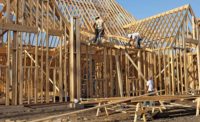Perini worked with the design team to create mock-ups of every type of repair that would be used. "That revealed a lot of great information as we went forward as far as what would be the best products and processes," Collie adds. Lemieux said that, based on its studies, the team also designed a more flexible mortar to better accommodate movement.
For Dutchman repairs, the team used existing attic stock of matching marble, but there wasn't enough to complete all repairs. The quarries used when the monument was built in the 19th century are either closed or now produce aggregate. Following some investigations, the team located reclaimed marble in Baltimore from the same geologic formation to meet its needs.
To the general public, the most striking aspect of the repair work was the scaffold system. Again, the team leveraged past experience, using designs from the 2000 repair as the basis for the new system. Collie says this enabled the team to expedite submittals.
Scaffolding supplier Universal Builders Supply was very familiar with the system, since it also worked on the 2000 repairs. Collie says aluminum framing was used as much as possible to reduce the risk of rust dripping on the monument and for lighter hoisting. The most notable difference from the original system is that the hoist was moved from the interior to the exterior to accommodate swing stages.
Due to the project's location near the White House, safety and security measures have been of particular concern. Background checks were required for all employees. Everyone, including special visitors, must watch a safety video before entering the jobsite. Through January, the project had no lost time accidents.
"From the very beginning, we had to think 10 steps ahead," Morelli says. "To make sure we stayed on schedule, we had to anticipate all potential obstacles and challenges."







Post a comment to this article
Report Abusive Comment